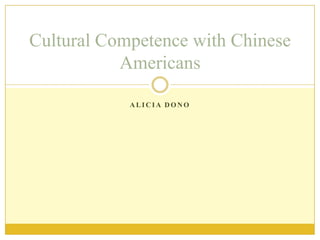
Cultural competence with chinese americans
- 1. Cultural Competence with Chinese Americans ALICIA DONO
- 2. Statistics Chinese Americans make up 1.2% of the total US population, and they are the largest Asian ethnic group, comprising almost 25% of all Asian Americans. The Chinese American population is very economically diverse. While their median income is higher than the national median income, there are slightly more Chinese Americans in poverty than the national average. Traditional Chinese Medicine is the most common form of healthcare among first generation immigrants. TCM is mainly guided by a holistic concept of health that emphasizes achieving balance and harmony throughout bodily systems.
- 3. History of Chinese Americans The majority of Chinese Americans are from one of two nations: either from the mainland of China or Taiwan. Chinese people have been immigrating to the United States since the late 1800s. There has since been an increase in immigration. According the U.S. Census, 70% of Chinese Americans are foreign born.
- 4. Immigrating to the United States The first Asian immigrant group to enter the US was the Chinese in the 1840s. Mostly single men, these sojourners were looking for their “mountain of gold” in order to make good money, buy a business or land, and return to China as prosperous successes. This was their dream. Their reality in California in the 1800s and 1900s was hostile confrontation, exclusions, and even fatalities because of riots against them. In 1882, legislation was passes (the Chinese Exclusion law) that halted immigration and exacerbated the already discriminatory practice of not allowing Chinese immigrants to become citizens. Although in 19434 the Exclusion Act was finally repealed, much pressure, such as being driven out of their work and communities, was put upon the Chinese laborers to return to China. Some succumbed, but despite the racist and discriminatory practices against them because they worked for wages lower than their Euro-American counterparts, many remained in the US and formed Chinatown communities.
- 5. Chinese Americans Religious Culture All kinds of religions are practiced in the Chinese American Community today. There are Christians as well as Buddhists, Daoists, and Confucianist. Chinese churches and temples are found wherever there are Chinese Americans. Generally speaking, Chinese are pragmatic in their approach to life and religion. They are somewhat superstitious: they believe in the doctrines of fengsui, which are intended to help in the organization of a home, and they do not want to do anything they personally think is likely to offend the gods or the ways of nature. Toward this end, they choose what they want to worship and they worship them through certain objects or locations in nature.
- 6. Chinese-American Family Culture Today, most middle-class Chinese Americans place the highest priority on raising and maintaining the family: providing for the immediate members of the family, acquiring an adequate and secure home for the family, and investing comparatively greater amounts of time and annual income in their children’s education. Even in poorer families, which have neither financial security nor decent housing, keeping the family intact and close and doing all they can to support their children are also priorities.
- 7. Chinese-American Youth and Elderly Culture Youth Children learn that high achievement, hard work and responsibility bring honor to the family name. During adolescence, stress arises out of the conflict of living up to family expectations while adapting to Western cultural values at school. Elderly Respect for the wisdom and contributions of the elderly are an essential part of Chinese culture. The elderly usually remain at home where they are taken care of by the family.
- 8. Barriers to learning faced by Chinese American students Research has helped us realize that mature, able, bright, and caring Asian students require almost three and a half years to feel at home in American and participate fully in the academic life. Students must first resolve the following educational barriers to increasingly participate in class on a par with American students. 1. The amount of time needed to assimilate a classroom question and formulate a verbal response. 2. The complexity of language comprehension problems. 3. The fear of ridicule of the limited language skills. 4. The sense of isolation. 5. The difficulty in preparing written assignments. 6. The inadequacy of conventional approaches to problem-solving. 7. The problems experienced with a teacher’s classroom presentation.
- 9. Classroom-based support mechanisms Although research has described pain and difficulty as they confronted the barriers to learning, they also expressed joy and happiness as they began to move toward fuller participation in their classes. Classroom support involves the kind of support the individual instructor may provide. 1. Instructor presentation. Teachers talk too fast for Asian students. Teachers must speak standard English with a slow delivery pace. 2. Classroom teaching aids. Provide student with classroom notes. 3. Concept review. 4. Special assistance on research papers. 5. Glossary of terms used. 6. Frequent formative and summative assessments. They easily prepare for them, studying hard, covering the material, and learning it well.
- 10. Resources for Chinese Americans http://parentseyes.arizona.edu/promise/ Educational Website about Chinese Heritage Chinatown: http://www.sanfranciscochinatown.com/history/ind ex.html Chinese American Citizen Alliance: http://www.cacanational.org/ Chinese Historical Center: http://www.chsa.org/ Chinese Culture Center of San Francisco http://www.c-c-c.org/
- 11. Resources http://ssrdqst.rfmh.org/cecc/index.php?q=node/24 Chinese-American Outreach Guide: Caring Connections http://www.everyculture.com/multi/Bu-Dr/Chinese- Americans.html http://www.learn-accounting-visually.com/barriers.html Culturally Competent Practice: A Framework for Understanding (Chapter 12)